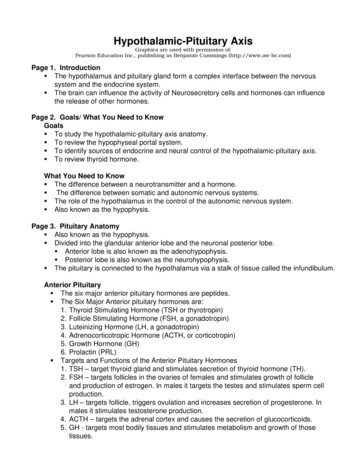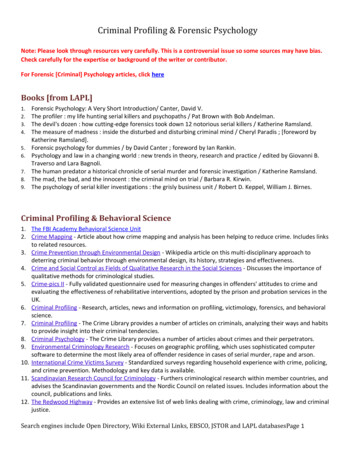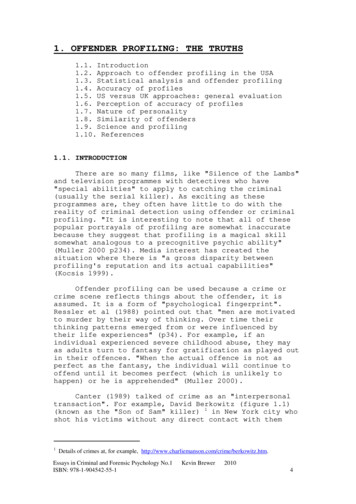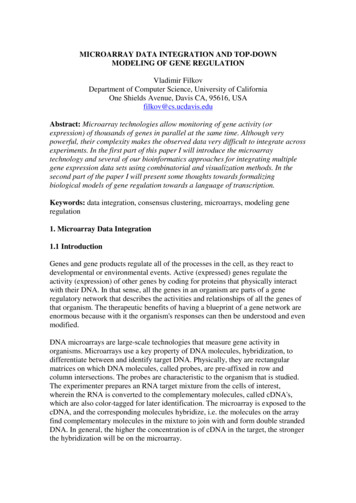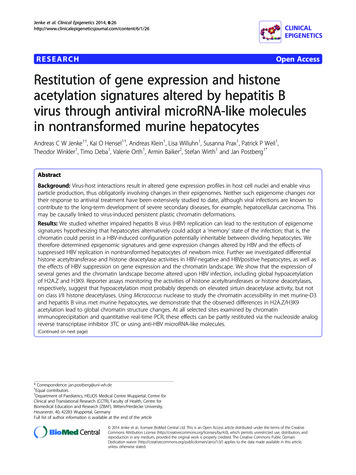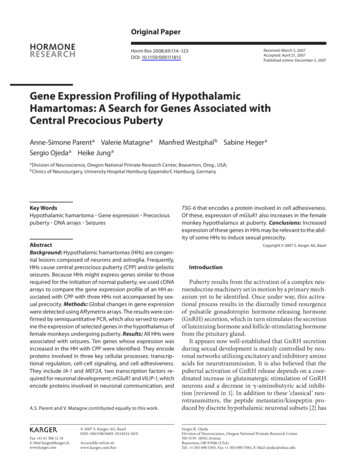
Transcription
Original PaperHORMONERESEARCHReceived: March 5, 2007Accepted: April 21, 2007Published online: December 5, 2007Horm Res 2008;69:114–123DOI: 10.1159/000111815Gene Expression Profiling of HypothalamicHamartomas: A Search for Genes Associated withCentral Precocious PubertyAnne-Simone Parent a Valerie Matagne a Manfred Westphal b Sabine Heger aSergio Ojeda a Heike Jung aabDivision of Neuroscience, Oregon National Primate Research Center, Beaverton, Oreg., USA;Clinics of Neurosurgery, University Hospital Hamburg-Eppendorf, Hamburg, GermanyKey WordsHypothalamic hamartoma Gene expression Precociouspuberty DNA arrays SeizuresAbstractBackground: Hypothalamic hamartomas (HHs) are congenital lesions composed of neurons and astroglia. Frequently,HHs cause central precocious puberty (CPP) and/or gelasticseizures. Because HHs might express genes similar to thoserequired for the initiation of normal puberty, we used cDNAarrays to compare the gene expression profile of an HH associated with CPP with three HHs not accompanied by sexual precocity. Methods: Global changes in gene expressionwere detected using Affymetrix arrays. The results were confirmed by semiquantitative PCR, which also served to examine the expression of selected genes in the hypothalamus offemale monkeys undergoing puberty. Results: All HHs wereassociated with seizures. Ten genes whose expression wasincreased in the HH with CPP were identified. They encodeproteins involved in three key cellular processes: transcriptional regulation, cell-cell signaling, and cell adhesiveness.They include IA-1 and MEF2A, two transcription factors required for neuronal development; mGluR1 and VILIP-1, whichencode proteins involved in neuronal communication, andA.S. Parent and V. Matagne contributed equally to this work. 2007 S. Karger AG, Basel0301–0163/08/0692–0114 24.50/0Fax 41 61 306 12 34E-Mail karger@karger.chwww.karger.comAccessible online at:www.karger.com/hreTSG-6 that encodes a protein involved in cell adhesiveness.Of these, expression of mGluR1 also increases in the femalemonkey hypothalamus at puberty. Conclusions: Increasedexpression of these genes in HHs may be relevant to the ability of some HHs to induce sexual precocity.Copyright 2007 S. Karger AG, BaselIntroductionPuberty results from the activation of a complex neuroendocrine machinery set in motion by a primary mechanism yet to be identified. Once under way, this activational process results in the diurnally timed resurgenceof pulsatile gonadotropin hormone-releasing hormone(GnRH) secretion, which in turn stimulates the secretionof luteinizing hormone and follicle-stimulating hormonefrom the pituitary gland.It appears now well-established that GnRH secretionduring sexual development is mainly controlled by neuronal networks utilizing excitatory and inhibitory aminoacids for neurotransmission. It is also believed that thepubertal activation of GnRH release depends on a coordinated increase in glutamatergic stimulation of GnRHneurons and a decrease in -aminobutyric acid inhibition [reviewed in 1]. In addition to these ‘classical’ neurotransmitters, the peptide metastatin/kisspeptin produced by discrete hypothalamic neuronal subsets [2] hasSergio R. OjedaDivision of Neuroscience, Oregon National Primate Research Center505 N.W. 185th AvenueBeaverton, OR 97006 (USA)Tel. 1 503 690 5303, Fax 1 503 690 5384, E-Mail ojedas@ohsu.edu
Table 1. HHs used in this study and associated clinical characteristicsPatientAge at surgeryPrecocious pubertyGenderAge at onsetof pubertyGnRHtreatmentSeizures123457 years, 8 months9 years5 years, 2 months37 years14 yearsYesNo3 months after surgeryNoYesMMFMF3–4 years–5 years, 3 months–5 yearsYes–YesYesYesYesYes1–Yes1Discontinued before surgery.been recently identified as playing a pivotal role in theinitiation of puberty [3, 4]. GnRH neuronal activity is notonly controlled by these transsynaptic inputs, but also byglial cells that facilitate GnRH secretion via the activationof signaling pathways initiated by growth factors actingon receptors endowed with tyrosine- and serine-threonine kinase activity [reviewed in 1].The search for those precipitating events responsiblefor the initiation of puberty may benefit not only fromstudying the normal process of puberty in animal modelsand humans, but also from the analysis of pathologicalconditions affecting pubertal development in humans.Hypothalamic hamartomas (HHs) represent one of theseconditions. They are congenital nonneoplastic lesionscontaining mature brain tissue in a heterotopic location,commonly associated with the base of the hypothalamus[5]. In most cases, HHs contain neurons and astroglialcells of normal aspect in addition to astrocytes and ependymoglial-like cells [6]. If HH are symptomatic, they arefrequently associated with central precocious puberty(CPP) and/or gelastic seizures, a form of ictal laughter[7].In both sexes, sexual precocity caused by HH occursmuch earlier (1–2 years of age) than idiopathic precociouspuberty, which predominantly affects females. The mechanism by which they advance puberty so dramatically isstill unknown. Because HHs appear to contain all thenecessary components to initiate the pubertal process ata very early age, they might hold critical information concerning the transcriptional and/or signaling componentsunderlying sexual precocity and the initiation of normalpuberty in humans. In this study, we used cDNA microarrays to compare the gene expression profiles of an HHassociated with CPP to that of HHs not accompanied byprecocious puberty with the aim of identifying geneswhose expression may be selectively altered in the HHwith CPP. The results showed the genes most highly overGene Expression Profiling ofHypothalamic Hamartomasexpressed in the HH associated with CPP were genes encoding transcriptional regulators required for neuronaldifferentiation and survival, and genes encoding proteinsrequired for excitatory cell-cell communication.Patients and MethodsPatientsHHs from 4 patients were used for DNA array analysis andsemiquantitative PCR. In addition, the expression of selectedgenes from a fifth HH was analyzed by semiquantitative PCRonly. In all cases, the HHs were surgically resected due to intractable seizure activity. With the exception of patient 3 and 5, allother patients were males. Only patients 1 and 5 exhibited CPPbefore surgery (table 1). However, the evolution of these two caseswas different, because the HH of patient 5 was removed at 14 yearsof age (9 years after CPP was diagnosed), during the course ofnormal puberty and 1 year after discontinuation of treatmentwith a GnRH agonist. The HH of patient 1 was resected muchsooner (at approximately 8 years of age), 4 years after the manifestation of CPP, and while the patient was still being treated witha GnRH agonist. The 3 other patients had seizures, but not CPPat the time of HH resection. Patient 3 (female) exhibited CPP 3months after surgery (table 1). A fragment of each HH was routinely processed for histopathological examination, and tissuesamples not needed for diagnostic purposes were stored at –80 Cfor future reference or research.These preexisting samples were sent to Beaverton, Oreg., USAas unlinked, anonymous specimens for RNA processing. The experimental protocol for this project was approved by the Institutional Review Board for Human Subjects of the Oregon Health &Science University.Nonhuman PrimatesThe hypothalamic tissue used in this study derived from earlyjuvenile (8.9–11.7 months of age, n 5), late juvenile (1.2–1.8 yearsof age, n 4), early pubertal (2–3 years of age, n 4) and mid-pubertal (3–4 years of age, n 6) female monkeys (Macaca mulatta)that had been euthanized for a variety of reasons and obtainedthrough the Oregon National Primate Research Center (ONPRC)Necropsy Program. The developmental stages of the animals weredefined according to the criteria proposed by Watanabe andHorm Res 2008;69:114–123115
Table 2. Genes showing a 2-fold increase or more in an HH associated with precocious puberty (HH-1) in comparison to HHs not accompanied by sexual precocity (HH-2 to 4)AccessionNo.Gene identity1- vs. 2-foldincrease1- vs. 3-foldincrease1- vs. 4-foldincreaseMean foldincreaseU30872.1NM 002196.1NM 005587.1NM 000838.2NM 003385.1AI040163AF047033.1Centromere protein F (mitosin)Insulinoma-associated 1 (IA1)MEF2A transcription enhancer factor 2Glutamate receptor metabotropic 1 (mGluR1A)Visinin-like 1 (VILIP-1)Calcium channel, voltage-dependent, 2-subunitSolute carrier family 4, sodium bicarbonate cotransporter,member 7 (SLC4A7)Transmembrane protein 16C (C11ORF25)T cell activation leucine repeat-rich proteinTumor necrosis factor alpha-stimulated gene 6 3.25AJ300461.1R41498NM 007115Terasawa [8]. All procedures were approved by the ONPRC Animal Care and Use Committee in accordance with the NIH guidelines for the use of animals in research.RNA ExtractionTotal RNA from the HH samples and the nonhuman primatebrain was extracted as outlined in online supplementary note 1(www.karger.com/doi/10.1159/000111815). RNA from the humanplacenta and human fetal brain was purchased from BD Biosciences (San Jose, Calif., USA); total RNA from human hypothalami was obtained from Ambion (Austin, Tex., USA).Sample Preparation and Microarray HybridizationMicroarray assays were performed by the Affymetrix Microarray Core of the OHSU Gene Microarray Shared Resource, asdescribed in online supplementary note 2 (www.karger.com/doi/10.1159/000111815).Microarray Data AnalysisImage processing and expression analysis were carried out using Affymetrix Microarray Suite (MAS) 5.0 software, as describedin online supplementary note 3 (www.karger.com/doi/10.1159/000111815). The array data have been deposited in NCBIs GeneExpression Omnibus (GEO, http://www.ncbi.nlm.nih.gov/geo/;accession number GSE7142).ined were GnRH, TGF , KiSS1, and GPR54 using primers andPCR conditions described in online supplementary note 4. Densitometric analysis of the gels was performed using Quantity Onesoftware (Bio-Rad, Hercules, Calif., USA). The results are expressed as arbitrary units resulting from dividing the densitometric value obtained for each mRNA of interest by the corresponding cyclophilin value found in each sample.Semiquantitative PCR Analysis of IA-1, TSG-6 and mGluR1AmRNA Expression in Monkey HypothalamusFive hundred nanograms of total RNA from each sample werereverse transcribed as indicated above. The PCR primers (onlinesuppl. note 5, www.karger.com/doi/10.1159/000111815), chosenusing Primer Express software (PR Applied Biosystems) were selected from monkey cDNA sequences atisticsDifferences between two groups were analyzed using the Student t test. When comparing several groups, the differences wereanalyzed by one-way ANOVA followed by the Student-NewmanKeuls multiple comparison test for unequal replications.ResultsSemiquantitative PCR Validation of Array ResultsFive genes showing an increased expression of 2-fold or greater in the HH associated with CPP (patient 1, male) versus the HHsfrom the 2 male patients without CPP (patients 2 and 4), and theHH from a female patient showing puberty after surgery (HH-3)were selected for PCR verification of the array results. The samegenes were also examined in an additional HH (patient 5) notsubjected to array analysis. The five genes studied were IA-1,VILIP-1, TSG-6, mGluR1A, and MEF2A (table 2). Reverse transcription of total RNA (50 ng) from each sample and PCR amplification was performed as outlined in online supplementary note4 (www.karger.com/doi/10.1159/000111815). Other genes exam-116Horm Res 2008;69:114–123Identification of Genes Predominantly Expressed inan HH Associated with CPPTo identify genes sharing a similar expression profilein HH-1 (the HH from patient 1 who had CPP and seizures) in comparison to HH-2 to 4 (the HHs from patients 2–4 who had seizures, but not CPP at the time ofsurgery), we used a K-means clustering algorithm provided by J-Express 2.0 software (http://www.ii.uib.no/ bjarted/jexpress). A group of 10 genes whose expresParent /Matagne /Westphal /Heger /Ojeda /Jung
Table 3. Cellular and molecular functions of genes showing a 2-fold increase or more in an HH associated with precocious puberty(HH-1) in comparison to HHs not accompanied by sexual precocity (HH-2 to 4)Gene identityCellular processMolecular functionTissue specificityTRGCentromere protein F (mitosin)Mitosis regulationChromosome segregation:microtubule binding proteinEmbryonic tissue,malignant tissueYesInsulinoma-associated 1 (IA1)TranscriptionalregulationTranscription repressor ofNeuroD/beta2Fetal brain,fetal pancreas,neuroendocrine tumorsYesMEF2A transcription enhancer factor 2TranscriptionalregulationActivates transcriptionMuscle,brainYesGlutamate receptor metabotropic 1 (mGluR1A)Cell-cellcommunicationMetabotropic glutamatereceptorBrainNoVisinin-like 1 (VILIP-1)Cell-cellcommunicationCalcium sensor proteinBrain, pancreasYesCalcium channel, voltage-dependent, 2-subunitCell-cellcommunicationVoltage-gated calciumchannelBrain, heart, pancreasNoSolute carrier family 4, sodium bicarbonatecotransporter, member 7 (SLC4A7)Cell-cellcommunicationCoupled transport of sodiumand bicarbonate: maintainsintracellular pHBrain, testis, spleenNoTransmembrane protein 16C (C11ORF25)Cell-cellcommunicationTransporter for unidentifiedsubstrateEar, brainYesT cell activation leucine repeat-rich proteinCell-cellcommunicationMembrane proteinBrain (adult and fetal),kidney, ovaryNoTumor necrosis alpha-stimulated gene 6(TSG-6)Cell adhesiveness,cell-cellcommunicationHyaluronic acid bindingproteinBrain, ovaryYesTRG Tumor-related gene.sion was consistently greater (2-fold or more) in HH-1than in HH-2 to 4 was selected (table 2). The functions ofthe encoded proteins were determined using three different search tools: the Swiss-Prot database (www.expasy.ch), GOMiner (http://discover.nci.nih.gov/gominer/)and IHOP (www.ihop-net.org/UniPub/iHOP/). Thisanalysis indicated that the genes overexpressed in HH-1encode proteins involved in three fundamental cellularprocesses: transcriptional regulation, cell-cell communication and cell adhesiveness (table 3). With the possibleexception of CENP-F (mitosin), a cell cycle-regulated nuclear protein [9] found at very low levels in the normalbrain (http://source.stanford.edu), but that is overexpressed in malignant tissues, including astrocytomas andmeningiomas [10 and references therein], all other genesare highly expressed in the normal developing brain ineither neurons, astrocytes or both (table 3).Validation of the Array Results bySemiquantitative PCRBased on their perceived importance in the control ofHH cell function, five of the genes overexpressed in HH1 were selected for PCR validation: IA-1 and MEF2A, twotranscriptional regulators [11, 12]; mGluR1 and VILIP-1,two genes encoding proteins involved in cell-cell signalling [13, 14], and TSG-6, a gene encoding a multifunctional secreted protein that participates in cell-cell adhesion via binding to hyaluronan, a component of the extracellular matrix [15].The increased abundance of IA-1 mRNA detected byPCR in HH-1 as compared to HH-2 and 4 (all from malepatients) was essentially identical to that detected byDNA arrays (fig. 1a). HH-3, derived from a female patientwho developed CPP shortly after HH resection, exhibitedan abundance of IA-1 mRNA intermediate between HH-Gene Expression Profiling ofHypothalamic HamartomasHorm Res 2008;69:114–123117
and 4 (fig. 1b). However, MEF2A mRNA levels in HH-1were similar to those in HH-3, a finding at variance withthe array results that detected a 2-fold increase in MEF2Aexpression in HH-1 as compared to HH-3 (table 2). LikeIA-1 mRNA, MEF2A expression was as low in HH-5 as inHH-2 and 4.The differences in mGluR1A and VILIP-1 mRNAabundance between HH-1 versus HH-2, 3 and 4, assessedby semiquantitative PCR, were similar to those estimatedby the arrays (fig. 2a, b). HH-5 had VILIP-1 mRNA levelsas high as in HH-1, but mGluR1A mRNA values as low asin HH-2, 3 and 4, suggesting that not all genes with increased expression in HHs associated with CPP remainpermanently activated. As in the case of IA-1 andmGluR1A, there was excellent agreement between theTSG-6 mRNA levels detected by PCR and the arrays(fig. 2c). TSG-6 mRNA prevalence in HH-5 was as low asin HH-2, 3 and 4.Fig. 1. Selective overexpression of the mRNAs encoding the transcriptional regulators IA-1 (a) and MEF2A (b) in an HH associ-ated with CPP (HH-1) as compared with three HHs not accompanied by CPP (HH-2 to 4), and one HH (HH-5) removed 9 yearsafter the occurrence of CPP. White bars represent the relative levels of IA-1 and MEF2A mRNAs detected by cDNA arrays, usingthe mRNA levels found in HH-1 as 100%. Black bars representrelative expression levels detected by semiquantitative PCR, normalized to the cyclophilin mRNA content of each sample, andcalculated using the mRNA levels in HH-1 as 100%. The gels depicting the PCR products used to calculate these densitometricvalues are shown on top of each bar graph. – PCR, no RT control.1, HH-2 and HH-4, suggesting that IA-1 expression mighthave been already increasing at the time of surgery. IA-1mRNA levels were not elevated in HH-5, which was removed from a female patient 9 years after the diagnosisof CPP was made.Consistent with the array results, MEF2A mRNA content measured by PCR was higher in HH-1 than in HH-2118Horm Res 2008;69:114–123Expression of GnRH, TGF , KiSS1 and GPR54in HHsBecause earlier reports showed the presence of GnRH[16 and references therein] and TGF [17] in HHs, expression of these genes was also examined. In addition,we sought to determine if KiSS1 and GPR54 are expressedin HHs, because of recent findings indicating that activation of GPR54 receptors by kisspeptin, the processed protein product of the KiSS1 gene, is a critical transsynapticinput to GnRH neurons required for the initiation of puberty [3, 4].As shown in figure 3a and b, both GnRH and TGF mRNAs were detected in all five HHs examined, regardless of their association with CPP. GnRH mRNA levelswere higher in HH-2, despite the lack of association ofthis HH with precocious puberty, and TGF mRNAabundance was highest in HH-3, which resulted in CPPafter resection of the tumor. KiSS1 mRNA was undetectable in all five HHs (fig. 3c), but GPR54 mRNA was expressed in some HHs (HH-1 to 3), and absent in others(HH-4 and 5) (fig. 3d). Thus activation of GPR54 receptors within HHs does not appear to be a primary mechanism by which HHs induce sexual precocity.Ontogeny of IA-1, mGluR1A and TSG-6 Expression inthe Female Monkey HypothalamusBecause IA-1, mGluR1A and TSG-6 expression is consistently increased in HH-1, we sought to determine ifsimilar changes occur in the primate hypothalamus during the normal onset of puberty. Female rhesus monkeyswere used, because the intrinsic neuroendocrine mechaParent /Matagne /Westphal /Heger /Ojeda /Jung
Fig. 3. The genes encoding GnRH (a), TGF (b), KiSS1 (c) andGPR54 (d) are not selectively expressed in an HH associated withCPP (HH-1) in comparison to three HHs not accompanied by CPP(HH-2 to 4), and one HH (HH-5) removed 9 years after the occurrence of CPP. Notice that while GnRH and TGF are expressed inall HHs, KiSS1 is not expressed in any. In contrast GPR54 mRNAis found in three of the five HHs studied. Also notice that TGF mRNA abundance is higher in HH-3, which was resected from apatient who underwent CPP not before, but shortly after surgery.MM Molecular marker; – PCR, no RT control; HH humanhypothalamus; HFB human fetal brain; HP human placenta.Fig. 2. Selective overexpression of the mRNAs encoding the cellcell communication molecules mGluR1A (a), VILIP-1 (b) andTSG-6 (c) in an HH associated with CPP (HH-1) as comparedwith three HHs not accompanied by CPP (HH-2 to 4), and oneHH (HH-5) removed 9 years after the occurrence of CPP. Whitebars represent the relative levels of mGLuR1A, VILIP-1 and TSG6 mRNAs detected by cDNA arrays, using the mRNA levels foundin HH-1 as 100%. Black bars represent relative expression levelsdetected by semiquantitative PCR, normalized to the cyclophilinmRNA content of each sample, and calculated using the mRNAlevels in HH-1 as 100%. The gels depicting the PCR products usedto calculate these densitometric values are shown on top of eachbar graph. – PCR, no RT control.Gene Expression Profiling ofHypothalamic Hamartomasnisms underlying the onset of puberty in this species aresimilar to those operating in humans [18]. The content ofmGluR1A mRNA increased (p ! 0.05) in the hypothalamus (fig. 4a), but not in the cerebral cortex (inset), at theinitiation of puberty, remaining moderately elevatedthereafter. Neither IA-1 nor TSG-6 mRNA abundance increased in the hypothalamus during postnatal development (fig. 4b, c).Identification of Genes with Decreased Expression inHH with CPPFifteen genes showed a 2-fold or greater decrease inexpression in HH-1 as compared with HH-2 to 4 (onlineHorm Res 2008;69:114–123119
other 14 genes with decreased expression in HH-1, thecontribution of GSTM5 to HH-induced puberty is obscure.DiscussionFig. 4. Expression of mGluR1A (a), but not that of IA-1 (b) or TSG6 (c), increases in the medial basal hypothalamus (MBH) of fe-male rhesus monkeys at the time of puberty, as assessed by semiquantitative PCR. Values are expressed as the ratio between eachgene of interest and the levels of cyclophilin mRNA detected ineach sample. The increase in hypothalamic mGluR1A mRNAcontent was not observed in the cerebral cortex (CTX, inset in a).* p ! 0.05 vs. early juvenile group. EJ Early juvenile (8.9–11.7 months of age); LJ late juvenile (1.2–1.8 years of age); EP early puberty (2–3 years of age); MP mid-puberty (3–4 yearsof age). Bars are mean and vertical bars represent SEM. Numbers on top of bars in a indicate the number of animals pergroup.suppl. table 1, www.karger.com/doi/10.1159/000111815).The greatest decrease observed was in glutathione Stransferase M5 (GSTM5) mRNA levels. GSTM5 is anenzyme that contributes to the detoxification of carcinogens, products of oxidative stress, and environmentaltoxins, by conjugation with glutathione [19]. Like the120Horm Res 2008;69:114–123The present study demonstrates that expression of adiscrete cohort of genes involved in transcriptional control, cell-cell communication and cell adhesiveness is increased in an HH associated with sexual precocity incomparison with HHs that do not elicit advanced sexualdevelopment. The common feature linking all cases (including HH-5, which was not analyzed by DNA arrays)is that all patients had seizures, and all had been unsuccessfully treated with antiepileptic drugs prior to surgery.However, because HHs are only resected when they giverise to intractable seizures, the number of HHs availablefor analysis was necessarily small and variable with regard to age at surgery, gender of the patients, and pubertal history.Despite these differences, the selective increase in geneexpression observed in HH-1 was remarkably consistentwith the neuroendocrine clinical features of each patient.Thus HH-2 and 4, derived from patients in whom sexualprecocity never occurred, exhibited essentially identicaldifferences in gene expression when compared to HH-1.The differences between HH-1 and HH-3 were uniformly less accentuated, and they were more variable in thecase of the few HH-5 genes examined. It is, therefore, possible that the initiation of puberty observed in patient 3after surgery may have been related to activation of thesame genes whose expression is increased in HH-1. Theincreased prevalence of TGF mRNA found in this HHis consistent with this possibility. Judging from the limited information gathered from HH-5, it would also appear that gene activation is not a permanent feature ofHH neuropathology. The fact that sexual precocity wasarrested in patients 1 and 5 by long-term GnRH antagonist treatment is also an important factor that needs to betaken into account when interpreting the results, becausethe GnRH treatment itself may have caused some of thechanges in gene expression we detected.The present results do not identify gene defects thatmay be responsible for the development of HHs, but suggest that HHs associated with CPP have a gene expressionprofile distinct from that of HHs not eliciting prematuresexual development. They also suggest that genes showing increased expression in the HH associated with CPPmay be more useful for an understanding of this condiParent /Matagne /Westphal /Heger /Ojeda /Jung
tion than genes with a decreased expression. Examination of additional HHs associated with sexual precocityis necessary to verify the validity of these concepts.We recently used DNA microarrays to query the hypothalamus of female rhesus monkeys during pubertaldevelopment (Roth et al., unpubl. data), and quantitativeproteomics to identify hypothalamic proteins that mightbe down- or upregulated in a mouse model of delayedpuberty [20]. The results of these studies showed that expression of certain genes previously described as beinginvolved in ‘tumor suppression’ – but that otherwise playa role in maintaining normal cell differentiation processes – increases in the hypothalamus at the time of monkeypuberty (Roth et al., unpubl. data) or decreases in micewith delayed puberty [20]. A prominent example of a tumor suppressor gene now found to play a critical role inthe initiation of puberty is KiSS1 [3, 4]. Before its functionin the control of puberty was discovered, KiSS1 wasknown as a suppressor of tumor metastases [21].Of the 10 genes showing increased expression in HH1, six had been earlier proposed to have roles in tumorsuppression. One of them is CENP-F [10]. Two others, IA1 (insulinoma-associated-1, also known as INSM1) andMEF2A, are transcription factors. IA-1 is a zinc fingertranscriptional repressor involved in neuronal differentiation with expression restricted to the embryonic nervous system and neuroendocrine tumors [11 and references therein]. MEF2A, is a transcription factor also required for neuronal differentiation and survival [12], inaddition to dendritic arborization and dendritic spineformation [22]. Two additional genes related to tumorformation play a physiological role in cell-cell communication. One of them, VILIP-1 (visinin-like protein-1) is amember of the family of neuronal calcium sensor proteins [14]; loss of VILIP-1 expression is associated withaccelerated tumor cell invasiveness [23]. C11ORF25 encodes an eight-transmembrane protein with similarity tothree other genes located on chromosomes 11 and 12; likeother members of the family, C11ORF25 is amplified inmalignant tumors [24]. C11ORF25 is predicted to be involved in the intracellular transport of yet to be identifiedmolecules. Finally, TSG-6 (tumor necrosis factor-stimulated gene 6) was also highly expressed in HH-1. TSG-6is a multifunctional protein secreted in response to TNF stimulation and elevated cAMP levels that binds to hyaluronan, a component of the extracellular matrix [15]. Asa downstream component of p53-mediated cell cycle arrest [25], TSG-6 is a potential tumor suppressor gene. Itthus appears that in both normal puberty and HHs thereis an activation of genes that, having diverse cellular func-tions, share the common feature of having been earlieridentified as involved in tumor suppression.An additional gene encoding a protein involved incell-cell communication and found to be upregulated inHH-1 is much less well-characterized. This gene, T cellactivation leucine-rich repeat containing 8 (LRRC8) is amember of a highly conserved family of leucine-rich repeat proteins; LRRC8 may function as a receptor for anunknown ligand [26].Two genes encoding proteins involved in transmembrane ion mobilization are also overexpressed in HH-1: asplice variant of the L-type high voltage-activated Cav1.2channel -subunit [27], and the sodium bicarbonate cotransporter NBC3 (SLC4A7) [28]. The -subunits of LCa2 channels are critical modulators of the channel’sgating activity, and are required for the correct targetingof the Cav1.2 complex to the cell membrane [29]. Sodiumcoupled bicarbonate transporters are essential for the homeostatic maintenance of intracellular pH [28]. Micelacking NBC3 develop blindness and hearing loss due todegeneration of the corresponding sensory receptors, acondition similar to Usher syndrome [30].Among the genes showing increased expression inHH-1, IA-1 and VILIP-1 deserve special mention becauseof their reported role in pancreatic -cell/intestinal endocrine cell differentiation [31] and insulin secretion[32], respectively. Like in the pancreas, IA-1 might function in HHs to promote the differentiation of neurosecretory cells. IA-1 is highly expressed in the fetal brain, pancreas, and neuroendocrine tumors, but is absent in adulttissues [11, 33]. VILIP-1, a neuronal calcium sensor protein [14], is also expressed in pancreatic -cells where itmodulates insulin secretion instead of cell differentiation[32]. VILIP-1 also appears to mediate metabotropic receptor-induced synaptic plasticity [34]. Conceivably,coupling of mGluR1 to VILIP-1 may set in motion cAMPand cGMP-dependent pathways [14] that enhance the secretion of substances, such as PGE2, able to stimulateGnRH release. These considerations suggest that the defining feature distinguishing HHs able to induce CPPfrom HHs not associated with sexual precocity is thepresence of active neuroendocrine cells in HHs causingCPP. Of interest in this context is a recently describedcase of precocious puberty in a 2-year-old girl caused bya pancreatic neuroectodermal tumor [35].Previous studies showed that HHs are composed ofmature ne
No n h u m a nP r i m a t e s T he hypothalamic tissue used in this study derived from early juvenile (8.9-11.7 months of age, n 5), late juvenile (1.2-1.8 years of age, n 4), early pubertal (2-3 years of age, n 4) and mid-pu-bertal (3-4 years of age, n 6) female monkeys M ( acaca a) m t at ul
